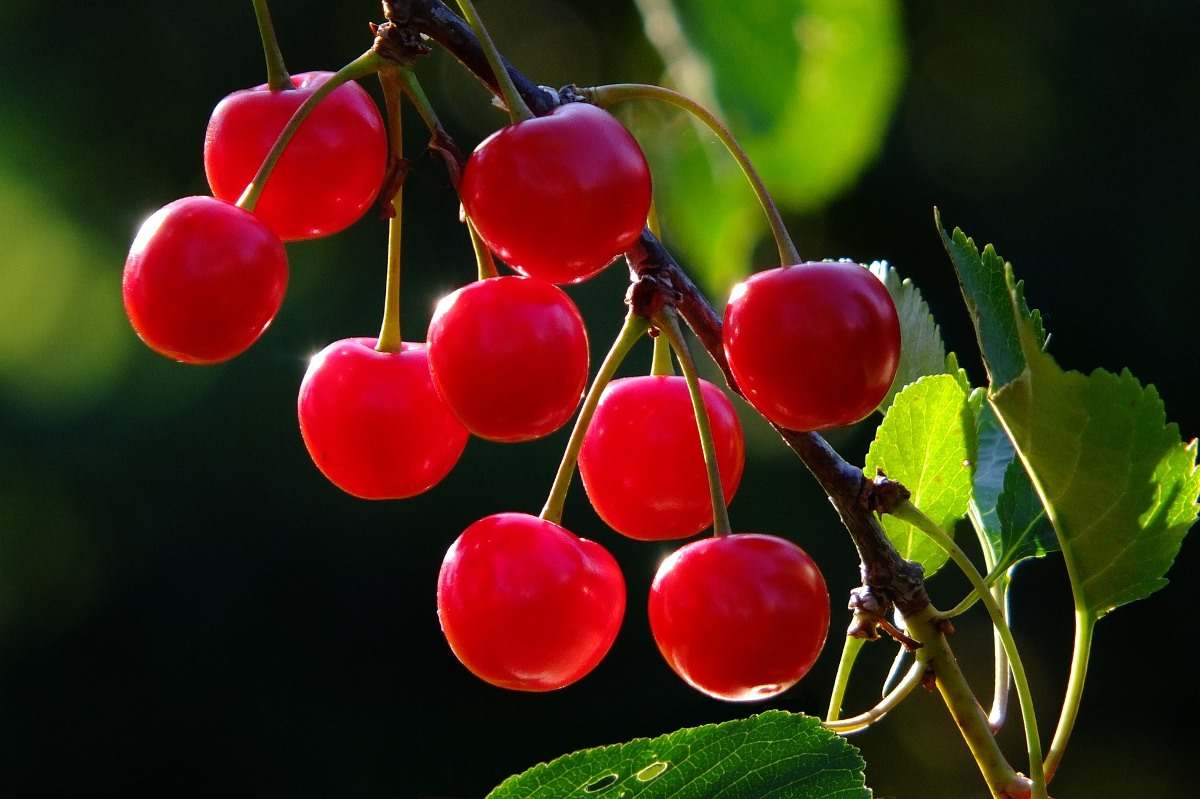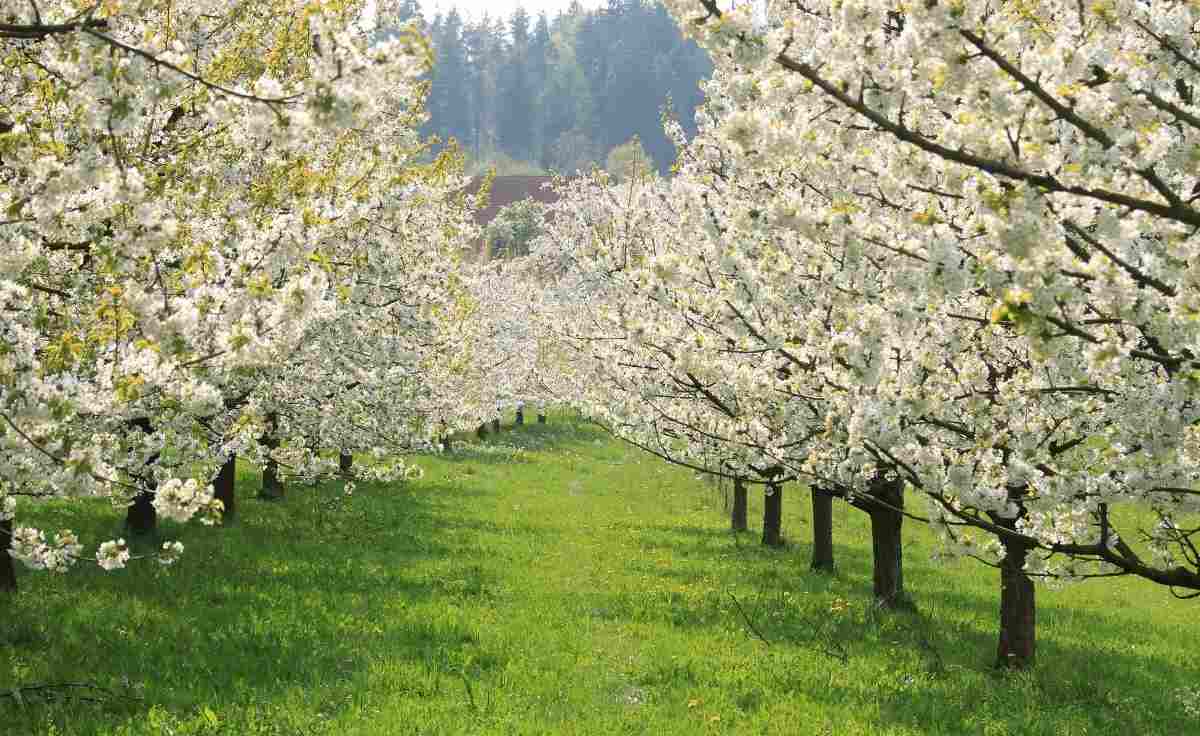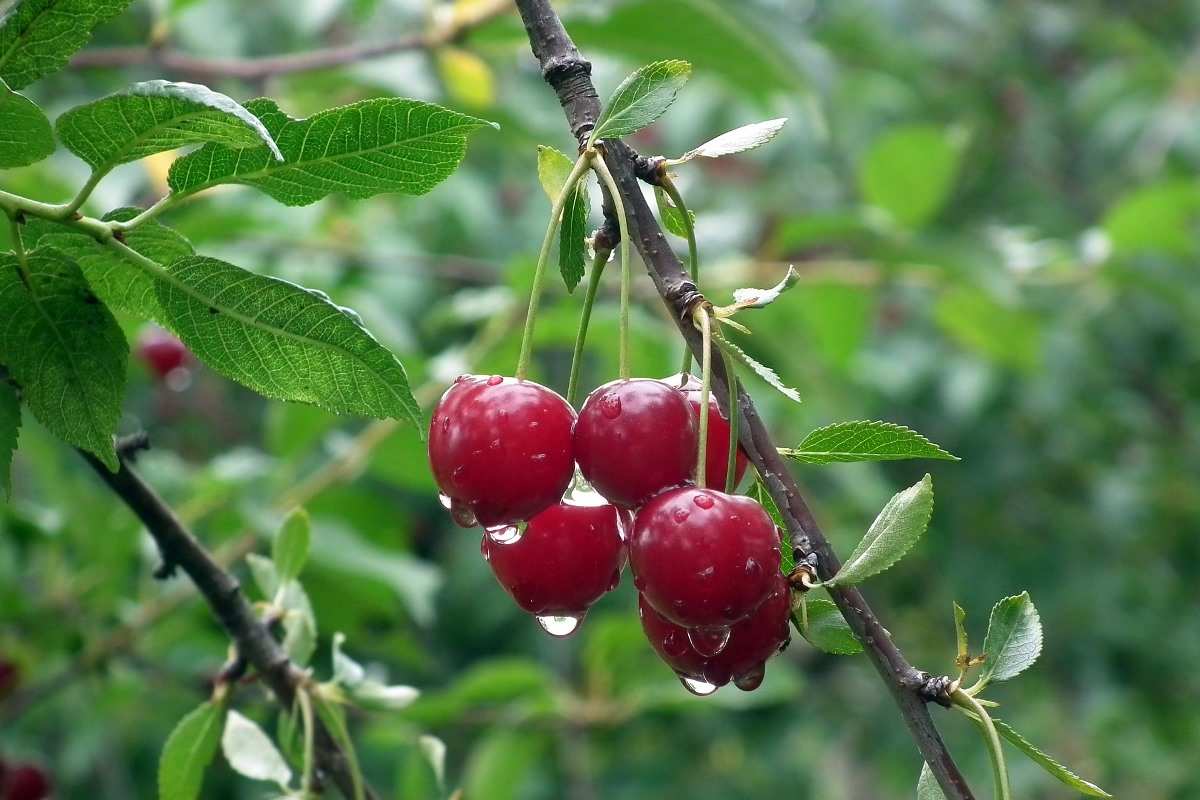Introduction to Organic Cherry Farming
Cherries are small and round fruits that can be sweet or sour. Cherries belong to the Rosaceae family. Organic fruit production contains more than simply excluding synthetic fertilizers and pesticides. Organic pest control, mainly labour costs for hand thinning and weed control, is usually more expensive than conventional practices. Quality and yield can vary widely, based on the growing season and management practices.
A Step by Step Guide to Organic Cherry Farming, and Cultivation Practices

Cherries prefer a deep sandy or sandy loam soil with a slightly acid to neutral pH level. Training and pruning will be approximately the same for all kinds of culture. Commercial organic Cherry production may have many challenges. The Cherry fruit fly, phytophthora root rot, bacterial canker, fruit cracking, leaf spot, late frosts, and brown rot of the blossom and fruit are all serious obstacles to the orchardist hoping to make a profit with Cherries, mainly for the organic grower.
Organic Soil Preparation for Cherry Farming
Cherries prefer sandy loam or sandy soils; with a pH level of 6.0 to 7.0 (6.2 to 6.8 is ideal). Clay soils would need to be significantly lightened with organic matter and gypsum and still might be too heavy. If soil is too heavy there is a chance the trees can be prone to diseases, such as Phytophthera. Siting of a cherry orchard is important, particularly for sweet Cherries. A sloping site is best because cold air is heavier than warm air and can drain away from the trees when in bloom. Better air circulation also helps prevent foliage diseases, such as powdery mildew, and fruit diseases such as brown rot. In winter, a sloping site will be slightly warmer than low spots and this might protect the bark from thawing and freezing. On a site sloping to the southwest or south, the bark is particularly susceptible to winter damage, which can lead to bacterial canker.
Soil and soil fertility constitute the center of the natural ecosystem. A less or more permanent soil cover prevents soil erosion and helps build up soil fertility. The constant supply of organic material feeds a huge number of soil organisms and provides an ideal environment for them. As a result, the soil becomes soft and capable of taking up and storing huge quantities of nutrients and water. Organic farmers give the main importance to the improvement of soil fertility. With the help of organic manures, they can stimulate the activity of soil organisms. Cover crops and mulching are used among other methods to prevent soil erosion.
Soil preparation can be done at any time of year, providing that the ground is not overly saturated with water or frozen. If your soil composition needs amending, you can use any of these, depending upon your goal:
- Compost (good for any soil)
- Sand (if your soil is clay)
- Manure (good for any soil)
- Garden lime (if native soil pH is too acid/low)
- Sphagnum/peat moss (if native soil pH is too high/alkaline)
The yard can provide you with plenty of free organic materials, such as grass clippings and shredded leaves. Not only will the grass and leaves break down to provide soil nutrients naturally, but they will help loosen the soil as well. You can gather these in the fall with spring planting in mind. Adding organic materials like compost will increases the composition of almost every soil type. Organic materials bind sandy soil particles so they hold nutrients and moisture better. They can also break apart clay and silt particles, so that water can soak in and roots can spread.
Different Cherry Varieties
There are 2 main types of Cherry trees: sweet and tart. Tart Cherries reach 20 feet tall, and dwarf varieties reach 6 to 8 feet tall. Sweet Cherry trees reach 40 feet tall, or about 25 feet tall with pruning, and dwarf varieties reach 6 to 10 feet tall. Mature organic Cherry trees do not require extensive care. They need light pruning to remove damaged branches and maintain a healthy shape, and they need disease and pest prevention measures.
Tart Cherries also called sour or pie Cherries, are easy to grow and use the tangy fruit for baking or let it overripen on the tree for fresh eating. Sour Cherry fruits are self-fertile and will set fruit alone. They grow only 20 feet tall and bear fruit at an earlier age than sweet Cherries.
Sweet Cherries do best in dry, mild climates, but some cultivars will do well in other climates with a little special care. Most sweet Cherries require a second compatible cultivar for pollination. Some sweet Cherries cannot pollinate other specific cultivars, so check before you plant. If you can only plant one tree, buy one grafted with two cultivars, or try a self-fertile cultivar such as Compact Stella. Sweet Cherries can grow into trees 35 feet or taller, but they are also available on dwarfing rootstocks that will keep the trees as small as 10 feet.
Planting Cherry Trees Organically
You should not miss this: Organic Avocado Farming.

Step 1) The perfect soil is a delicate balance of texture, acidity, depth, and content, but it’s not an unachievable one. In general, fruit trees thrive best in well-drained soil with a sandy, loamy texture. Preparing the soil before you plant will greatly increase your Cherry tree’s long-term performance and promote strong, healthy new growth. It is a good idea to have your soil tested before planting, and even annually after planting, to determine if it’s lacking in any essential ‘nutrients or minerals’.
Step 2) Space tart Cherries around 20 to 25 feet apart, sweet Cherries 25 to 30 feet apart. Dwarf trees should be planted with closer spacing. Let natural rainfall irrigate Cherry trees under normal conditions, only soaking occasionally during droughts. Irrigate slowly and deeply with a soaker hose or drip irrigation when the top 2 to 3 inches of soil are dry between spring flowering and summer fruiting, specifically during the last two weeks of fruit ripening.
Step 3) Mulch with a 2-inch layer of compost to the drip line in spring, before bud break. Apply a thick layer of organic mulch to the drip line to control weeds and maintain moisture. Pull back the mulch in winter.
Step 4) Sprinkle 2 ounces of a balanced fertilizer per each inch of trunk diameter after harvest and before midsummer.
Step 5) Remove branches that cross or rub together, dead or damaged wood, and branches that block sunlight to inner limbs. Thin branches to within 1/8 inch beyond a bud.
Step 6) Harvest Cherries when they are ripe and fully red. Pluck the Cherries softly, being careful to not tear off the fruit spur. Harvest Cherry fruit every other day for about a week.
Step 7) Spray the tree with copper sulfate spray two or three times during the winter to control the disease. Cover the tree with netting before the fruit develops to prevent hungry birds from eating it. Rake up fallen leaves in winter and dispose of them in a plastic bag.
Organic Nutrient Management in Cherry Farming
Nutrient management particularly organic manures and biofertilizers based on the soil test results. If the dosage of nitrogenous fertilizers is too high the tree becomes too succulent and therefore susceptible to insects and diseases. If the dosage is too low, the tree growth is retarded. So, the planters should apply an adequate amount for the best results. The phosphatic fertilizers must not be applied every season as the residual phosphate of the previous season will be available for the current season also.
Organic nutrient management is depending on biodegradable material, i.e. animal and plant residues. Nutrient cycles are closed with the help of mulching, composting, green manuring, crop rotation, etc. Farm animals can play a significant role in the nutrient cycle: their dung is of high value and its use enables nutrients provided with the fodder to be recycled. If carefully managed, losses of nutrients due to soil erosion, leaching and gasification can be decreased to the minimum. This decreases the dependency on external inputs and helps to save costs. Though, nutrients exported from the farm with the sold produce need to be replaced.
Fertilizing is a better way to replenish the nutrients in your soil, particularly nitrogen. Nitrogen encourages green vegetative growth, which is exactly what you want to promote before your Cherry tree reaches its fruit-bearing years. Always test your soil before applying any fertilizers. Different soils can have varying amounts of native elements required to support Cherry tree development and growth. If you discover your soil lacks any necessary nutrients (phosphates, nitrogen, potash, etc.), be sure to select a fertilizer that supplements the soil’s nutrient deficiency.
Organic fertilizing in cherry farming can be done by applying a layer of;
- Compost, or
- Blood, fish, or cottonseed meal (for nitrogen)
- Decomposed manure, or
- Rock phosphate, Bone meal, and seaweed meal (for phosphorous, potassium, and trace minerals).
Spread fertilizers around the base of the tree, starting around 6 inches away from the trunk and extending to the drip-line and water it into the soil. Apply nitrogen fertilizers at a rate of 68 grams of nitrogen per inch of trunk diameter. Compost contains an average of 1 to 4% nitrogen, based on the source material. A blood meal is around 13% nitrogen by weight.
Organic Mulching in Cherry Farming
Mulching is the process of covering the topsoil with plant material such as grass, leaves and crop residues. A mulch cover improves the activity of soil organisms such as earthworms. They help to create a soil structure with plenty of larger and smaller pores through which rainwater can infiltrate easily into the soil, thus reducing surface runoff. As the mulch material decomposes, it improves the content of organic matter in the soil. Soil organic matter helps to create good soil with a stable crumb structure. Therefore, the soil particles will not be easily carried away by water. So, mulching plays an important role in preventing soil erosion.
Organic Pest and Diseases Management in Cherry Farming
Pest and disease management in organic agriculture consists of a range of activities that support each other. Several management practices are long-term activities that aim at preventing pests and diseases from affecting a crop. Management focuses on maintaining existing pest populations and diseases low. Alternatively, is a short-term activity and focuses on killing pest and disease. The general approach in organic agriculture is to deal with the causes of a problem rather than treating the symptoms, an aspect that also applies to pests and diseases. So, management is of a much higher priority than control.
Black Knot – Black Knot is a fungal disease and caused by Apiosporina morbosum that shows up as knot-like structures on branches and twigs. These should be pruned out of the Cherry trees as soon as noticed. Cut three to four inches below the knot with sterilized tools (10% bleach or Lysol in water, or isopropyl alcohol). Sterilize tools again after each cut. A lime-sulfur spray in the dormant season will help control black knot.
Powdery mildew – Powdery mildew is a fungus caused by Podosphaera clandestine, is rarely seen on Cherry leaves and twigs. It is more prevalent in high heat with humidity. Powdery mildew will cause loss of yield and vigor. Open pruning, creating a central leader with alternate branching, discourages mildew. Resistant varieties will help with this problem; Black Tartarian, Bing, and Rainier are particularly susceptible to powdery mildew. Most tart Cherries are susceptible, too. Sulfur made into a spray will also control powdery mildew, but also will a spray have made with baking soda.
Leaf spot – Leaf spot is another fungus mainly affecting tart Cherries, which is caused by Blumeriella Jaapii. This fungus causes leaves to turn yellow and later, holes to form in the leaves. It is more common in humid climates than here in Montana but sometimes is seen. Orchard sanitation is a good preventative. The fungus overwinters on fallen leaves, so these should all be raked up and destroyed in fall. Copper fungicide sprays will control this disease. Spray at petal fall, again when dead flower petals fall off fruit, and again two weeks later. Copper sprays can damage tree foliage, especially in temperatures above 26°C, so should be used in cooler weather for best results.
Hungry birds and fruit cracking are two of the major issues that can happen while raising Cherries. Most of the disease and insects are less serious on tart Cherries as compared to sweet.
Peachtree borer, green fruit worm, plum curculio, mites, and Cherry fruit fly are the insects that usually attack Cherries. Scale and Aphids can also create issues. Sawfly larvae are also known as pear slugs, which can cause the plant to die.
Shothole borers can damage the fruits as they create small holes in the bark of trunk and twigs. Mostly, the holes are covered with gum. During the summer, spring, and fall, you need to paint the branches and trunk with white latex to prevent the adults from laying eggs. Most of the time, these pests attack the damaged or wounded plants. Their appearance is the sign that your trees are in some serious trouble and you might need to remove a few of them.
The disfigured leaves and blossoms are the sign of pear thrips. Although predatory mites (naturally occurs) provide controls against them, if you notice serious infections, you can separate insecticidal soap.
When and How to Harvest Cherries
You may also check this: Hydroponic Garlic Farming.

You’ll need to pay extra attention to your Cherries in the period before harvesting. It’s advisable to check the size and colour of the fruit daily during this time. The taste of the Cherries is the best indication of whether they’re ready to be harvested or not. It’s possible to harvest the Cherries from one tree up to 6 times in one season.
In case if you are interested in this: Growing Organic Cucumbers In Containers.